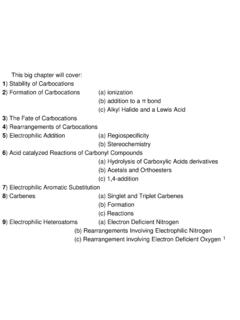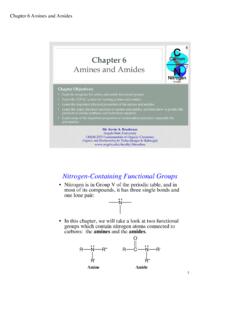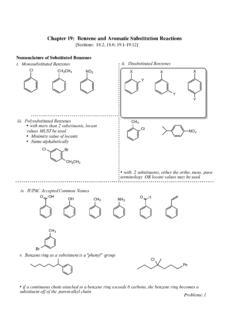Transcription of Professor J. Stephen Clark
1 1 Heterocyclic ChemistryHeterocyclic ChemistryProfessor J. Stephen ClarkRoom C4-04 Email: 20122 Recommended Reading Heterocyclic Chemistry J. A. Joule, K. Mills and G. F. Smith Heterocyclic Chemistry(Oxford Primer Series) T. Gilchrist Aromatic Heterocyclic Chemistry D. T. Davies3 Course Summary Definition of terms and classification of heterocycles Functional group chemistry: imines, enamines, acetals, enols, and sulfur-containing groups Synthesis of pyridinesIntroductionIntermediates used for the construction of aromatic heterocycles Synthesis of aromatic heterocycles Examples of commonly used strategies for heterocycle synthesis Carbon heteroatom bond formation and choice of oxidation state Pyridines General properties, electronic structure Electrophilic substitution of pyridines Nucleophilic substitution of pyridines Metallation of pyridinesPyridine derivatives Structure and reactivity of oxy-pyridines, alkyl pyridines, pyridinium salts, and pyridineN-oxidesQuinolines and isoquinolines General properties and reactivity compared to pyridine Electrophilic and nucleophilic substitution quinolines and isoquinolines General methods used for the synthesis of quinolines and isoquinolines4 Course Summary (cont)
2 General properties, structure and reactivity of pyrroles, furans and thiophenes Methods and strategies for the synthesis of five-membered heteroaromatics Fisher and Bischler indole synthesesFive-membered aromatic heterocycles Electrophilic substitution reactions of pyrroles, furans and thiophenes Metallation of five-membered heteroaromatics and use the of directing groups Strategies for accomplishing regiocontrol during electrophilic substitutionIndoles Comparison of electronic structure and reactivity of indoles to that of pyrroles reactions of indoles with electrophiles Mannich reaction of indoles to give 3-substituted indoles (gramines) Modification of Mannich products to give various 3-substituted indoles1,2 and 1,3-Azoles Structure and reactivity of 1,2- and 1,3-azoles Synthesis and reactions of imidazoles, oxazoles and thiazoles Synthesis and reactions of pyrazoles, isoxazoles and isothiazoles5 Introduction Heterocycles contain one or more heteroatoms in a ring Aromatic, or partially or fully saturated this course will focus on aromatic systems Heterocycles are important and a large proportion of natural products contain themXYXYXZ carbocycleheterocycles X, Y, Z are usually O, N or S Many pharmaceuticals and agrochemicals contain at least one heterocyclic unit Heterocyclic systems are important building-blocks for new materials possessing interesting electronic.
3 Mechanical or biological properties6 Classification Aromatic Six-MemberedIsoelectronic carbocycleHeterocyclesN1 Oisoquinolinepyryliumpyridazinepyrimidin epyrazine2N3N45678NN123456NN2345671NN234 5618234561123456123456pyridinequinolineX 7 Classification Aromatic Five-MemberedIsoelectronic carbocycleHeterocyclesO12pyrrolefuranthi ophenethiazoleoxazoleimidazolepyrazolein doleisothiazole345isoxazoleNHS123451NH23 4NO51234NO1234556NS2512347NS5123434 NNH151NN2H345123458 Classification Unsaturated / SaturatedOOONHOOONHOHN4( )-pyronearomatic dipolar resonance form2-pyridoneUnsaturatedSaturatedOOOOTH FNHO ethylene oxide1,4-dioxanpyrrolidinedihydropyran9 Functional Group ChemistryImine Formation Removal of water is usually required to drive the reaction to completion If a dialkylamine is used, the iminium ion that is formed can t lose a proton and an enamine is formedR1R2OR1R2NR3R1R2NR3R1R2 OHR1R2 OHNR3 HHR1R2OH2NR3HR1R2NR3H HHR3NH2HH3O10 Functional Group ChemistryEnols and EnolatesR1OR1 OHketo formenol formER2R2R1OR2 HHBR1OR2R1OR2enolate Avoid confusing enols (generated under neutral/acidic conditions) with enolates(generated under basic conditions) The enol form is favoured by a conjugating group CO2R, COR, CN, NO2etc.
4 Enolates are nucleophilic through Cor Obut react with Celectrophiles through CR1OR3enol etherHR1OR3R2R1OR2R1R2OR3R3 OacetalR3 OHH2OR2 Enol Ethers11 Functional Group ChemistryEnaminesR1OR2 NHR3R3HR1NR2R3R3ER1NR3R3R2ER1NR3R3R2 HHH2OR1OR2ER1NR3R3R2enamineiminium ion(Schiff base) Analogues of enols but are more nucleophilic and can function as enolate equivalents Removal of water ( by distillation or trapping) drives reaction to completion Enamines react readily with carbon nucleophiles at carbon Reaction at N is possible but usually reverses12 Functional Group ChemistryCommon Building-BlocksBuilding-Blocks for Sulfur-Containing Heterocycles During heterocycle synthesis, equilibrium is driven to the product side because ofremoval of water, crystallisation of product and product stability (aromaticity) Heterocycle synthesis requires:C O or C N bond formation using imines, enamines, acetals, enols, enol ethersC C bond formation using enols, enolates, enaminesR1R2OP2S5R1R2 SRSHR1SR2thioketonesthiolsthioethersOHOR H2 NONH2H2 NNHNH2NH2 OROOR2R1NH2 NHROOOR2R1amidinesamidescarboxylic acidsureaguanidine -diketones -keto esters13 General Strategies for Heterocycle SynthesisRing ConstructionManipulation of Oxidation StateYXYXX, Y = O, S, NRconjugate addition + + + Cyclisation 5- and 6-membered rings are the easiest to form C X bond formation requires a heteroatom nucleophileto react with a Celectrophile Unsaturation is often introduced by elimination dehydration, dehydrohalogenationX[O] H2X H2[O]XX H2[O]
5 Xoraromaticdihydrotetrahydrohexahydro14 General Strategies for Heterocycle SynthesisOONH3 NHNH3 NNHOONH 2H2O 2H2 OXXC ommon Strategies 4+1 Strategy Strategy can be adapted to incorporate more than one heteroatomXX 5+1 Strategy 1,5-Dicarbonyl compounds can be prepared by Michael additionof enonesO ONH3 NHH H2[O]N 2H2O15 General Strategies for Heterocycle SynthesisXXorXXXorX 3+2 Strategy 3+3 StrategyExamplesXXH2NH2 NOHH2 NOH2NO + OO + +NH2NH2 OHOHEEOHO +OHal + +Hal = Cl, Br, I16 Bioactive PyridinesNNHH nicotineNNSOOHNH2sulphapyridine Nicotine is pharmacologically active constituent of tobacco toxic and addictive Paraquat is one of the oldest herbicides toxic and non-selective NNHONH2isoniazide Sulphapyridine is a sulfonamide anti-bacterial agent one of the oldest antibiotics Isoniazide has been an important agent to treat tuberculosis still used, but resistanceis a significant and growing problem NMeNMeparaquat17 Drugs Containing a Pyridine2008 Ranking: 2 brandedDisease: Acid reflux2008 Sales: $ billionCompany: AstraZenecaNONHSOOName: Nexium2008 Ranking: 87 brandedDisease: Chronic myeloid leukemia2008 Sales: $ billionCompany: NovartisName: Gleevec2008 Ranking: 10 brandedDisease: Type 2 diabetes2008 Sales: $ billionCompany: Eli LillyName: Actos2008 Ranking.
6 34 brandedDisease: Duodenal ulcers and acid reflux2008 Sales: $ billionCompany: EisaiName: AciphexNHNSONOOMeNNNHNHNONNNHNSONOMeMeO1 8 Pyridines N<< DNH<< + + + Isoelectronic with and analogous to benzene Stable, not easily oxidised at C, undergoes substitution rather than addition I Effect (inductive electron withdrawal) M EffectNNNHHHetc. Weakly basic pKa~ in H2O (lone pair is notin aromatic sextet) Pyridinium salts are also aromatic ring carbons are more + than in parent pyridine19 Pyridines SynthesisTheHantzsch synthesis( 5+1 ) The reaction is useful for the synthesis of symmetrical pyridines The 1,5-diketone intermediate can be isolated in certain circumstances A separate oxidation reaction is required to aromatise the dihydropyridineMeMeMeMeOOO OPhHMeMeOOMeMeOOPhMeMeOOPhHOMeMeOONH3 pH additionaldol condensation and dehydrationMeMeMeMeOONHPhHHNO3 MeMeMeMeOPhONoxidationMeOMeMeOOH2 NPhHMe20 Pyridines SynthesisFrom Enamines or Enamine Equivalents theGuareschi synthesis( 3+3 )Using Cycloaddition reactions ( 4+2 )
7 The -cyano amide can exist in the enol formCO2 HNCO2 HMeMeONCO2 HMeMeOHHHNOMeMeMeMeCO2 HNMeNCO2 HHHOMe H2O Diels-Aldercycloaddition70%H+ Oxazoles are sufficiently low in aromatic character to react in the Diels-Alder reactionEtO2 CMeCNMeNMeCNH2 NOOCO2 EtMeOCNH2NK2CO3K2CO3 MeOCNCO2 EtNH73%21 Pyridines Electrophilic ReactionsN NENEENEEEE EPathways for the Electrophilic Aromatic Substitution of Pyridines The position of the equilibrium between the pyridine and pyridinium salt depends onthe substitution pattern and nature of the substituents, but usually favours the salt 22 Pyridines Electrophilic ReactionsRegiochemical Outcome of Electrophilic Substitution of Pyridines The -substituted intermediate, and the transition state leading to this product, have more stable resonance forms than the intermediates/transition states leading to the / products NNNNNNNNHEHEHEHEHEHEHEHENHE Resonance forms with a positive charge on N( 6 electrons) are very unfavourable23 Pyridines Electrophilic reactions Regiochemical control is even more pronounced in the case of pyridinium ionsRegiochemical Outcome of Electrophilic Substitution of Pyridinium Ions NNNNNNNNHEHEHEHEHEHEHEHENHEEEEEEEEEEN + + + In both pyridine and pyridinium systems, substitution is favoured but the reaction isslower than that of benzene Reaction will usually proceed through the small amount of the free pyridine available24 Pyridines Electrophilic ReactionsNSubstitutionCSubstitutionNMeMe INNSO3NO2 BF4 ROClNNO2BF4 ClNORSO3, CH2Cl2 Reaction at Cis usually difficult and slow, requiring forcing conditions Friedel-Crafts reactionsare not usually possible on free pyridines25 Pyridines Electrophilic ReactionsNitration of PyridineUse of Activating GroupsNc-H2SO4, c-HNO3 NNO26% !
8 300 C, 24 h Multiple electron-donating groups accelerate the reaction Both reactions proceed at similar rates which indicates that the protonation at Noccursprior to nitration in the first caseNMeMeMec-HNO3, oleumNMeMeMeHNMeMeMeMeINMeMeMeMec-HNO3, oleumIINMeMeMeNO2 NMeMeMeMeNO2100 C100 C70%90%26 Pyridines Electrophilic ReactionsSulfonation of PyridineHalogenation of PyridineNClNBr2, oleumNBr130 C86%Cl2, AlCl3,100 C33% Low yield from direct nitration but good yield via a mercury intermediate Forcing reaction conditions are required for direct halogenationNH2SO4, SO3 NHgSO3 NSO3H70%HgSO4, H2SO4,220 C(low yield)27 Pyridines ReductionFull or Partial Reduction of Pyridines Pyridines generally resist oxidation at ring carbon atoms and will often undergoside-chain oxidation in preference to oxidation of the ringNHRH2, Pt,NNHRREtOHNa-NH3,NHRAcOH, rtNa, EtOH Full or partial reduction of the ring is usually easier than in the case of benzene 28 Pyridines Nucleophilic ReactionsRegiochemical Outcome of Nucleophilic Addition to Pyridines Nitrogen acts as an electron sinkNNNNuNuNuNHNuNHNuNHNuNHNuNHNuNHNuNHN uNHNuNHNu Substitution is less favoured because there are no stable resonance forms with the negative charge on N Aromaticity will is regained by loss of hydride or a leaving group, or by oxidation29 Pyridines Nucleophilic ReactionsNClNaOEtNOEtNO2 ClNClNClNClNucleophilic Substitution The position of the leaving group influences reaction rate ( > >> ) NXNuNNuXNu = MeO , NH3, PhSH = Cl, Br, I, (NO2)
9 Favoured by electron-withdrawing substituents that are also good leaving groupsRelative rate 80 40 1 3 10 430 Pyridinium Ions Nucleophilic ReactionsNMeClOO2 NNMeONO2 Nucleophilic Substitution Conversion of a pyridine into the pyridinium salt greatly accelerates substitutionRelative rate 5 104 1 10 4 Substituent effects remain the same ( , >> ) but now > NXNuNNuXNu = MeO , NH3, PhSH = Cl, Br, I, (NO2)RRNMeClNMeClNMeClNCl31 Pyridines Pyridyne FormationSubstitution via an Intermediate Pyridyne When very basic nucleophiles are used, a pyridyne intermediate intervenesNH2 NClHNClHNH2 NaNH2 NaNH2 NNH2HH2 NNNNH2 HNH2NH2 NNNH244%27%benzyne Pyridynes are similar to benzynes and are very reactive (not isolable)32 Pyridines Nucleophilic ReactionsNucleophilic Attack with Transfer of Hydride A hydride acceptor or oxidising agent is required to regenerate aromaticityNPhNHNH2OO2 (air)LiLiNH2 LiNPhHNH2 NPhLi, Et2O, 0 C H2 LiNNHXHNH2 NHX = H (NH3) / 2-aminopyridineLiNH2 The reaction with LiNH2is referred to as the Chichibabin reaction33 Pyridines Metal-Halogen ExchangeNXn-BuLiNLin-BuXX = Cl, Br, IDirect Exchange of Metal and a Halogen Metallated pyridines behave like conventional Grignard reagents Halogenated pyridines do not tend to undergo nucleophilic displacement with alkyl lithium or alkyl magnesium reagentsNBrn-BuLi,NLiNOPhPhCNH2 ONPhNNPhNHLiEt2O, 78 C34 Pyridines Directed MetallationUse of Directing Groups Directing groups allow direct lithiation at an adjacent positionNOOMet-BuLi,NONi-Pr2 NOLiMeONOLiNi-Pr2 PhNMe2 ONOOMeINONi-Pr2 OPhNMeMeMeMeLiEt2O, 78 CLiTMP, 78 CLiTMPI(CH2)
10 2Cl90% A Lewis basic group is required to complex the Lewis acidic metal of the base 35 Oxy-Pyridines StructureOxy-Pyridines/Pyridones Subject to tautomerism The , systems differ from the systems in terms of reactivity and structure In the case, the equilibrium is highly solvent dependent, but the keto form is favouredin polar solvents NHNHNNHNHNNNHNHOHOHOHOOOOO zwitterionzwitterionzwitterionONHONHONHO 1,3-dipole36 Amino Pyridines StructureAmino Pyridine Systems Contrast with oxy-pyridines Amino pyridines are polarised in the opposite direction to ReactionsNHONOHBr2, H2O, rtc-H2SO4, c-HNO3 NOHBrBrBrNHONO2100 C, 2 days38%Electrophilic Substitution Nis much less basic than that in a simple pyridine Substitution occurs ortho or para to the oxygen substituent (cf. phenols) reactions such as halogenation, nitration, sulfonation etc. are possible38 Oxy-Pyridines ReactionsNucleophilic Substitution Replacement of the oxygen substituent is possibleNOHClPCl4 PCl5 OPCl3 NClHClNOHPCl3 ClClNOHPCl3 ClClNOHPCl3 ClCl In this case, the reaction is driven by the formation of the very strong P=O bond39 Oxy-Pyridines ReactionsCycloaddition Oxy-pyridines have sufficiently low aromatic character that they are able to participateas dienes in Diels-Alder reactionswith highly reactive dienophilesNOMeMeMeCO2 MeCO2 MeNOCO2 MeCO2 MeMeMe40 Alkyl Pyridines DeprotonationDeprotonation with a Strong Base Deprotonation of and alkyl groups proceeds at a similar rate, but alkyl groups aremuch more difficult to deprotonate Bases are also potential nucleophiles for attack of the Salts ReactionsNMeHBH3 HBH3 EtOHNaBH4,NMeNMeHH3 BNMeNMeHBH3 NMeNMeNucleophilic Attack with Reducing Agents Nucleophilic attack is much easier (already seen this) Deprotonation of alkyl substituents is easier (weak bases are suitable)







